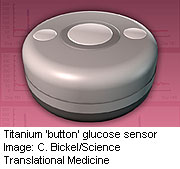
WEDNESDAY, July 28 (HealthDay News) — A new implantable blood sugar sensor might one day eliminate the need for the multiple daily finger sticks that people with diabetes must currently endure to check their blood sugar levels.
The new device was tested for more than a year in pigs, and it effectively monitored their blood sugar without the need for daily recalibration.
“This device would be implanted for a long term. It’s surgically implanted, like a pacemaker,” explained study author David Gough, a professor in the department of bioengineering at the University of California, San Diego.
Gough is also the founder of Glysens, a company that is manufacturing the new glucose monitor.
The findings are published in the July 28 issue of Science Translational Medicine.
Gough’s group isn’t the only one working on developing implantable glucose-sensing technology. Researchers at the Massachusetts Institute of Technology (MIT) are working on a similar device that uses different technology than Gough’s sensor.
People with diabetes — either type 1 or type 2 — must check their blood sugar frequently. The American Diabetes Association recommends that people check their blood sugar levels at least four times a day, but people taking insulin often check their blood sugar much more often than that, up to a dozen times a day. To check blood sugar levels, someone with diabetes must first draw a drop of blood using a lancet device to stick the finger.
There are also continuous glucose monitoring systems available that must be worn on the outside of the skin, with a small catheter piercing the skin to monitor blood sugar levels. Currently, these devices can only be worn for three to seven days and, in addition, must be recalibrated daily using a standard glucose meter and finger stick. These devices aren’t yet considered substitutes for blood glucose meters, but instead help people with diabetes know if their blood sugar levels are trending up or down so that they can make adjustments to their insulin levels or food intake.
These devices need to be recalibrated daily because a change in the transmitted signal occurs as scar tissue begins to form where the sensor is inserted, Gough explained.
“All implanted devices elicit a scar tissue response. But, with the proper design, you can avoid the influence of scar tissue,” he said, adding that his device gets around this problem by using a different sensing technology. The new device uses an enzyme that detects glucose and oxygen and also measures oxygen levels separately. Gough said the difference between those two measurements gives the blood sugar levels.
The device, which is about 1.5 inches in diameter and 5/8 of an inch thick, could be implanted in several places, he said. It could be placed under the collarbone, where pacemakers are implanted. Or, he said, it could be placed on the abdomen, just above the belt line.
He said the researchers haven’t yet designed the receiver that might be used in a consumer model, but that he envisions a small device, possibly a wristwatch, or an application that could be used with a cell phone.
In the current trial, the device was implanted in two pigs that initially weren’t diabetic. After nearly a year in the first pig, and after several weeks in the second pig, the pigs were given a medication that causes destruction of the insulin-producing cells in their bodies, essentially mimicking type 1 diabetes. The pigs wore the sensors for 520 days and 222 days, respectively.
Gough said the devices rarely needed to be recalibrated and that one sensor went 160 days without the need for recalibration. He doesn’t yet know what the recalibration time would be in humans, but said that the researchers are currently preparing an application to begin human studies.
In addition to replacing manual blood sugar checks, such a device might also be useful as part of an artificial pancreas system.
But one expert said the system isn’t perfect quite yet.
“This is a step in the right direction, but it still only gives us information on patterns and there’s still a gap of 10 to 20 minutes between the reading and [the] time it’s sent to the sensor,” noted Dr. Joel Zonszein, director of the clinical diabetes center at Montefiore Medical Center in New York City. “The good thing is that it was implanted for a year or more without a lot of decay. And once it’s calibrated, there wasn’t much need to recalibrate over time.”
More information
Learn more about the current state of continuous glucose monitoring from the U.S. National Institute of Diabetes and Digestive and Kidney Diseases.

